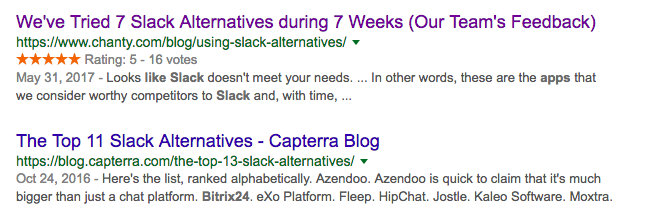Click-through rate (CTR) is one of the key metrics that can show you how efficient your content marketing strategy is. Be it a Facebook ad, an email newsletter or your website snippet on Google search, if people don’t click on it, all your efforts will be in vain.
And, if you are a self-funded startup, just like we are, you can’t afford to waste a single dollar you invest into your marketing.
Trying to market a startup on a shoestring seemed like a huge disadvantage at first. Yet, it turned out to be a valuable experience. Instead of throwing the cash around, we carefully selected only the most effective (and free!) strategies and tools.
The result – we were able to triple our organic CTR in less than a year, all while keeping our marketing expenses as low as possible.
Curious to learn more? Here are some of the tactics that worked for us as well as some eye-opening insights we sourced along the way.
1. Craft an irresistible headline
First of all, your article title needs to convey a clear message. Address a specific pain point, answer the reader’s’ question, offer a solution to their problems. To know exactly where you should be targeting in your title, look up the relevant keywords on Google Keyword Planner.
In our case, we started with pretty obvious variations of “team chat app” queries. And it worked just fine. Until we dug a little deeper[1] and found the hidden gem – long tail “[competitor] alternative” keywords. It turned out, there is a vast pool of prospective customers looking for the substitutes to the popular team communication apps (aka our major competitors).
Despite the lower traffic, such keywords turned out to be significantly easier to target and, as a result, get higher website rank. Plus, most long-tail queries tend to have a strong buying intent, and, as a result, higher conversion (up to 10% on average).

There are many ways to optimize your title for better CTR[2]. For example, using numbers and symbols (e.g. brackets) in your titles is a proven way to boost the click-through rate. Listicles or “how to” articles also tend to enjoy better readers’ attention. You can also mention the type of content, such as infographics, expert roundup, survey, etc., right in the title to make the readers click.
Another trend that we’ve noticed while experimenting with our headlines is that opinion-based, personalized titles have a higher CTR on average. Using words and phrases like “our feedback”, “we’ve tested”, “our team”, adds credibility and value to your headline.
Consider the following example.

Both articles offer an overview of the 7 Slack alternatives. Yet, which one would you choose — an article based on someone’s experience using the apps or another generic list of “top something?”
2. Break through the noise with your snippet
There is one more difference between the snippets in the example above. You’ve probably noticed the stars under the title and URL. Wow, you might think, 16 votes with the 5-star rating? Is this article really that good?
The thing is, this article currently ranks #3 on Google Search (preceded by an ad and a featured snippet). Yet, it still has a relatively high CTR, compared to the similar articles ranked #1. And it’s all thanks to the attention-catching snippet that stands out from the other results on this Google Search page.
If you want to make your snippet just as good, there are several aspects you need to pay attention to:
Description
Make it short and sweet, just enough to catch readers’ attention but don’t give away too much information. The ideal length[3] is 160-230 characters. To optimize your snippet (and title) length consider a handy tool by SEOmofo[4].
Just like titles, the description should include relevant keywords. Using different symbols can also help you increase the visibility and grow your organic CTR.
URL
The same principles apply to the link featured in your snippet. Make sure it is short, readable, and includes relevant keywords, so the people know they are on the right path to find the answers to their questions.
Additional elements
You can always include some extra details to make your snippet stand out. For example, an article can feature readers’ rating, date of posting, time to read, etc.
Here is an example of how we use the listed hacks to make our snippet from the previous example even more visible.

3. Make your content worth reading
As we already know, the higher your rank is, the more clicks you will get.

Yet, if you think that your job is done as soon as you get people to click your link on Google Search, think again. Our experience shows that the dwell time[5] (how long the visitors stay on your website after following a link to it) is as important as CTR.
What’s even more important, the two metrics are closely connected. Namely, some of our article with 15-20% CTR and a reasonably high dwell time have experienced a significant rank boost over time. It makes sense – why would Google bury your article on page 10 if the users seem to enjoy it?
That’s why creating an engaging and highly valuable content is the best strategy to both improve your Google Search position and CTR.
Mind several attributes of a high-quality content[6]:
- Unique and valuable insights (preferably experience or research-based)
- Clear and readable formatting
- Credible and data-backed judgements
- Visuals – images, charts, screenshots, videos, GIFs, or even memes
I guess it goes without saying that your content should have excellent grammar and style. Hiring a professional copywriter and editor is a sound investment, taking into account the business benefits of proper content marketing.
One more reason to put the quality of your content first is that such articles have a better chance to convert the readers into customers.

Ready to give your CTR a boost?
The CTR hacks we’ve covered in this article are only the tip of the iceberg. Content marketing and SEO are no easy tasks. It takes time and effort to get to the top 10 on Google Search (as well as to stay there for as long as you can).
In our experience, CTR depends on a number of factors, from your Google Search rank to the snippet you use. It can even be traced down to your backlinks[7] and other basic SEO elements. Yet, it all starts and ends with the quality content.
No matter how hard you try, you can’t possibly trick Google into loving a generic, yeah-whatever content that delivers no real value.
Feature image: Shuttestock.com
In – Post Image: Image given by author




